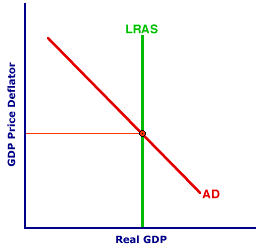
|
|
FACTOR DEMAND ELASTICITY: The elasticity of a factor demand curve is affected by four things: (1) the price elasticity of demand for the good produced, (2) the production function technology and elasticity of marginal physical product, (3) the ease of factor substitutability, and (4) the share of the factor's cost relative to total cost. Changes in any of these four items can cause the price elasticity of factor demand to change. In other words, the quantity of factor services demanded will become more or less sensitive to changes in the factor price.
Visit the GLOSS*arama
|
|


|

|
                           EQUILIBRIUM, LONG-RUN AGGREGATE MARKET: The state of equilibrium that exists in the long-run aggregate market when real aggregate expenditures are equal to full-employment real production with no imbalances to induce changes in the price level or real production. The opposing forces of aggregate demand (the buyers) and long-run aggregate supply (the sellers) exactly offset each other. At the existing price level, the four macroeconomic sectors (household, business, government, and foreign) purchase all of the real production that they seek and producers sell all of the real production that they have. While the focus of equilibrium in the long-run aggregate market is on balance between real expenditures and real production in the product markets, it also involves simultaneous equilibrium in the aggregated financial and resource markets. Long-run price flexibility ensures that all three aggregate markets are in equilibrium. Long-run equilibrium is one of two macroeconomic equilibrium alternatives found in aggregate market analysis. The other is equilibrium in the short-run aggregate market, which has equilibrium in the product and financial markets, but NOT in the resource markets.Equilibrium
Long-Run Aggregate Market |  |
The graph to the right can be used to illustrate equilibrium in the long-run aggregate market. First, to set up the graph, the vertical axis measures the price level (GDP price deflator) and the horizontal axis measures real production (real GDP). The negatively-sloped curve, labeled AD, is the aggregate demand curve and the vertical curve, labeled LRAS, is the long-run aggregate supply curve. Long-run equilibrium is the price level and real production obtained at the intersection of the AD and LRAS curves.Because the LRAS curve is vertical at full-employment real production, long-run equilibrium necessarily occurs at full employment, regardless of shifts in the AD curve or changes in the price level. To demonstrate that long-run equilibrium occurs at the same full-employment level of real production should aggregate demand change, click the [AD Increase] and [AD Decrease] buttons. An increase in aggregate demand leads to a higher price level, but the same level of real production. A decrease in aggregate demand leads to a lower price level, but also the same level of real production. Long-run aggregate market equilibrium means that there are no economy-wide product market shortages or surpluses. However, this does not necessarily mean that ALL product markets are in equilibrium. A complex economy, like that in the United States, is bound to have shortages in some product markets and surpluses in others, even in long-run equilibrium. As such, prices in some markets rise, while those in other markets fall. These sorts of imbalances in specific markets reflect the ongoing reallocation of resources at the microeconomic level. What is required for aggregate market equilibrium at the macroeconomic level is that the microeconomic shortages and surpluses cancel out, that rising prices cancel falling prices, that the price level and real production do not change. By far the most important implication of long-run equilibrium is full employment. Long-run price flexibility ensures that resource markets are in balance, with NO economy-wide shortages or surpluses. In particular, there is no cyclical unemployment or overemployment. Resource market equilibrium is what generates a LRAS curve that is vertical at full-employment real production. And because the LRAS curve is vertical at full-employment real production, long-run equilibrium, the intersection of the AD and LRAS curves, MUST result in full employment. The economy produces NOTHING BUT full-employment real production in the long run. This implication of long-run full-employment is most important for government policies. If the economy ALWAYS produces full-employment real production in the long run, then no action, no intervention, no stabilization policy, by government is needed. The goal of stabilization policies is to achieve full employment. If the economy is AT full employment, then such policies are unneeded. This lack of need for government policies is warmly embraced by political conservatives and others who prefer a limited role for government in the economy.

Recommended Citation:EQUILIBRIUM, LONG-RUN AGGREGATE MARKET, AmosWEB Encyclonomic WEB*pedia, http://www.AmosWEB.com, AmosWEB LLC, 2000-2025. [Accessed: July 18, 2025].
Check Out These Related Terms... | | | | | | | | |
Or For A Little Background... | | | | | | | | | | | | | | | | |
And For Further Study... | | | | | | | | | |
Search Again?
Back to the WEB*pedia
|



|

|
ORANGE REBELOON
[What's This?]
Today, you are likely to spend a great deal of time wandering around the downtown area trying to buy either shoe laces for your snow boots or a rim for your spare tire. Be on the lookout for the happiest person in the room.
Your Complete Scope
This isn't me! What am I?
|

|
|
The penny is the only coin minted by the U.S. government in which the "face" on the head looks to the right. All others face left.
|

|
|
"A winner is someone who recognizes his God-given talents, works his tail off to develop them into skills, and uses those skills to accomplish his goals. " -- Larry Bird, basketball player
|

|
M2
M1 plus savings types of near monies, including savings deposits, certificates of deposits, money market deposits, repurchase agreements, and Eurodollars
|

|
|
Tell us what you think about AmosWEB. Like what you see? Have suggestions for improvements? Let us know. Click the User Feedback link.
User Feedback
|


|


